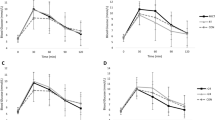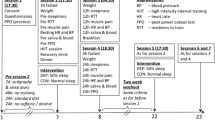Abstract
Purpose
To assess the acute effect of moderate and high-intensity exercise on markers of cardio-metabolic function among rotational shift workers.
Methods
Sedentary men (n = 26, age: 38 ± 8 years; BMI: 32.2 ± 6.0 kg/m2, VO2peak 32.6 ± 6.7 mL/kg/min) employed in rotational shift work were recruited and underwent objectively assessed sleep quality (~ 7 days actigraphy) prior to reporting for laboratory testing. Baseline venous blood was collected to analyse fasted glucose, insulin and inflammatory cytokines tumor necrosis factor (TNF)-α, interleukin (IL)-6 and IL-1 receptor antagonist (IL-1Ra). Participants were randomly allocated a 30 min cycling intervention of either high intensity interval training (HIIT): 1:4 ratio of 60 s at 100% and 240 s at 50% VO2peak, or moderate intensity continuous training (MICT); continuous cycling at 60% VO2peak. Fasted venous blood was collected post intervention (0, 30, 60 min) before subsequent night’s sleep was assessed via actigraphy.
Results
HIIT (P < 0.016) and MICT (P < 0.016) significantly increased IL-1Ra immediately and 30 min post exercise. Significantly decreased wake after sleep onset (WASO) were observed following MICT (P < 0.05). No significant changes were observed for supplementary sleep variables, insulin sensitivity, IL-6 or TNF-α for either intervention group (P > 0.05).
Conclusion
High- and moderate-intensity exercise acutely increase anti-inflammatory markers post exercise and MICT significantly reduces sleep fragmentation in rotational shift workers. Results which are associated with improved cardio-metabolic function and indicate the potential validity of exercise as an intervention to offset the hypothesised adverse health effects of rotational shift work.


Similar content being viewed by others
Data Availability
Data will be made available upon reasonable request.
References
Antuna-Puente B, Disse E, Rabasa-Lhoret R, Laville M, Capeau J, Bastard J-P. How can we measure insulin sensitivity/resistance? Diabetes Metab. 2011;37(3):179–88.
Bird SR, Hawley JA. Exercise and type 2 diabetes: new prescription for an old problem. Maturitas. 2012;72(4):311–6.
Bescos R, Boden M, Jackson M, Trewin A, Marin E, Levinger I, Conte F. Four days of simulated shift work reduces insulin sensitivity in humans. Acta Physiol. 2018;223(2):e13039.
Bonora E, Formentini G, Calcaterra F, Lombardi S, Marini F, Zenari L, Raffaelli A. HOMA-estimated insulin resistance is an independent predictor of cardiovascular disease in type 2 diabetic subjects: prospective data from the Verona Diabetes Complications Study. Diabetes Care. 2002;25(7):1135–41.
Borg G. Borg’s perceived exertion and pain scales. Champaign: Human kinetics; 1998.
Brestoff JR, Clippinger B, Spinella T, von Duvillard SP, Nindl B, Arciero PJ. An acute bout of endurance exercise but not sprint interval exercise enhances insulin sensitivity. Appl Physiol Nutr Metab. 2009;34(1):25–32.
Brown WM, Davison GW, McClean CM, Murphy MH. A systematic review of the acute effects of exercise on immune and inflammatory indices in untrained adults. Sports Med Open. 2015;1(1):35.
Carandente F, Montaruli A, Angeli A, Sciolla C, Roveda E, Calogiuri G. Effects of endurance and strength acute exercise on night sleep quality. Int SportMed J. 2011;12(3):113–24.
Cartee GD. Mechanisms for greater insulin-stimulated glucose uptake in normal and insulin-resistant skeletal muscle after acute exercise. Am J Physiol Endocrinol Metab. 2015;309(12):E949–59.
De Bacquer D, Van Risseghem M, Clays E, Kittel F, De Backer G, Braeckman L. Rotating shift work and the metabolic syndrome: a prospective study. Int J Epidemiol. 2009;38(3):848–54.
Flahr H, Brown WJ, Kolbe-Alexander TL. A systematic review of physical activity-based interventions in shift workers. Preventive medicine reports. 2018;10:323–31.
Gebel K, Ding D, Chey T, Stamatakis E, Brown WJ, Bauman AE. Effect of moderate to vigorous physical activity on all-cause mortality in middle-aged and older Australians. JAMA Intern Med. 2015;175(6):970–7.
Gibala MJ, Little JP, MacDonald MJ, Hawley JA. Physiological adaptations to low-volume, high-intensity interval training in health and disease. J Physiol. 2012;590(5):1077–84.
Kecklund G, Axelsson J. Health consequences of shift work and insufficient sleep. BMJ Br Med J. 2016. https://doi.org/10.1136/bmj.i5210.
Kervezee L, Kosmadopoulos A, Boivin DB. Metabolic and cardiovascular consequences of shift work: the role of circadian disruption and sleep disturbances. Eur J Neurosci. 2020;51(1):396–412.
Lange T, Dimitrov S, Born J. Effects of sleep and circadian rhythm on the human immune system. Ann N Y Acad Sci. 2010;1193(1):48–59.
Larsen P, Marino F, Melehan K, Guelfi KJ, Duffield R, Skein M. High-intensity interval exercise induces greater acute changes in sleep, appetite-related hormones, and free-living energy intake than does moderate-intensity continuous exercise. Appl Physiol Nutr Metab. 2019;44(5):557–66.
Leproult R, Holmbäck U, Van Cauter E. Circadian misalignment augments markers of insulin resistance and inflammation, independently of sleep loss. Diabetes. 2014;63(6):1860–9.
Libby P, Ridker PM, Maseri A. Inflammation and atherosclerosis. Circulation. 2002;105(9):1135–43.
Morita Y, Sasai-Sakuma T, Inoue Y. Effects of acute morning and evening exercise on subjective and objective sleep quality in older individuals with insomnia. Sleep Med. 2017;34:200–8. https://doi.org/10.1016/j.sleep.2017.03.014.
Nea FM, Pourshahidi LK, Kearney J, Livingstone MBE, Bassul C, Corish CA. A qualitative exploration of the shift work experience: the perceived barriers and facilitators to a healthier lifestyle and the role of the workplace environment. J Occup Environ Med. 2017;59(12):1153–60.
Petersen AMW, Pedersen BK. The anti-inflammatory effect of exercise. J Appl Physiol. 2005;98(4):1154–62.
Rehman K, Akash MSH. Mechanisms of inflammatory responses and development of insulin resistance: how are they interlinked? J Biomed Sci. 2016;23(1):1–18.
Schilperoort M, Rensen PC, Kooijman S. Time for novel strategies to mitigate cardiometabolic risk in shift workers. Trends Endocrinol Metab. 2020;31(12):952–64. https://doi.org/10.1016/j.tem.2020.10.005.
Shantha M. Sleep loss and circadian disruption in shift work: health burden and management. Med J Aust. 2013;199(8):11–5.
Sim AY, Wallman K, Fairchild T, Guelfi K. High-intensity intermittent exercise attenuates ad-libitum energy intake. Int J Obes. 2014;38(3):417.
Spira AP, Stone KL, Redline S, Ensrud KE, Ancoli-Israel S, Cauley JA, Yaffe K. Actigraphic sleep duration and fragmentation in older women: associations with performance across cognitive domains. Sleep. 2017. https://doi.org/10.1093/sleep/zsx073.
Stamatakis KA, Punjabi NM. Effects of sleep fragmentation on glucose metabolism in normal subjects. Chest. 2010;137(1):95–101.
Thomas JM, Kern PA, Bush HM, McQuerry KJ, Black WS, Clasey JL, Pendergast JS. Circadian rhythm phase shifts caused by timed exercise vary with chronotype. JCI insight. 2020;5(3):e34270. https://doi.org/10.1172/jci.insight.134270.
Torquati L, Mielke GI, Brown WJ, Kolbe-Alexander T. Shift work and the risk of cardiovascular disease. A systematic review and meta-analysis including dose–response relationship. Scand J Work Environ Health. 2018;44(3):229–38. https://doi.org/10.5271/sjweh.3700.
Vedaa Ø, Harris A, Bjorvatn B, Waage S, Sivertsen B, Tucker P, Pallesen S. Systematic review of the relationship between quick returns in rotating shift work and health-related outcomes. Ergonomics. 2016;59(1):1–14.
Woods JA, Wilund KR, Martin SA, Kistler BM. Exercise, inflammation and aging. Aging Dis. 2012;3(1):130.
Funding
This study was funded solely by the Australian Government Research Training Program.
Author information
Authors and Affiliations
Contributions
Review and editing (equal). BC: conceptualisation (lead); writing – original draft (lead); formal analysis (lead): supervision (lead). TH: conceptualisation. FM: conceptualisation. MS; conceptualisation; supervision.
Corresponding author
Ethics declarations
Conflict of Interest
There are no conflicts of interest associated with this manuscript.
Rights and permissions
Springer Nature or its licensor (e.g. a society or other partner) holds exclusive rights to this article under a publishing agreement with the author(s) or other rightsholder(s); author self-archiving of the accepted manuscript version of this article is solely governed by the terms of such publishing agreement and applicable law.
About this article
Cite this article
Collins, B.E.G., Hartmann, T.E., Marino, F.E. et al. A Comparison of Acute High- and Moderate-Intensity Exercise on Cardio- Metabolic Function and Sleep Among Shift Workers. J. of SCI. IN SPORT AND EXERCISE 6, 35–43 (2024). https://doi.org/10.1007/s42978-022-00212-x
Received:
Accepted:
Published:
Issue Date:
DOI: https://doi.org/10.1007/s42978-022-00212-x




